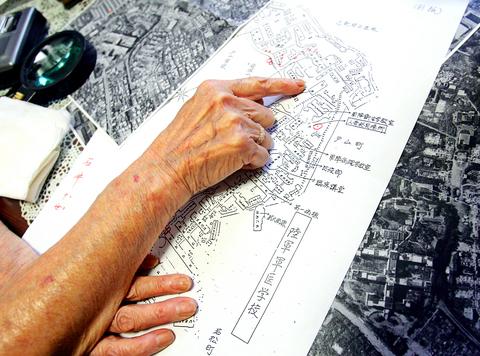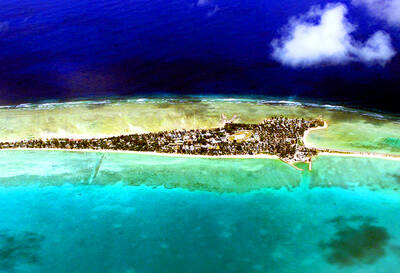The Toyama No. 5 apartment block is quiet at midday -- laundry flapping from balconies, old people taking an after-lunch stroll. But the building and its nearby park may be sitting on a gruesome World War II secret.
A wartime nurse has broken more than 60 years of silence to reveal her part in burying dozens -- perhaps hundreds -- of bodies there as US forces occupied the Japanese capital.
The way experts see it, these were no ordinary casualties of war, but possible victims of Tokyo's shadowy wartime experiments on live prisoners of war -- an atrocity that has never been officially recognized by the Japanese government.

PHOTO: AP
The neighborhood on the west side of Tokyo is deeply troubled.
"I feel sorry for remains with such a sad history," said Teppei Kuroda, a college senior who lives there.
Former nurse Toyo Ishii says that during the weeks following Japan's surrender on Aug. 15, 1945, she and colleagues at an army hospital at the site were ordered to bury corpses, bones and body parts -- she doesn't know how many -- before the Americans arrived.
A mass grave of between 62 and more than 100 possible war-experiment victims was uncovered in a nearby area in 1989. But Ishii's account -- publicly released in June -- could yield a far larger number and a firmer connection to Unit 731, Japan's dreaded germ and biological warfare outfit.
"If the bones are actually there, they are likely related to Unit 731 itself, because the facility that used to stand in that part of the compound was closely linked to the unit," said Keiichi Tsuneishi, a Kanagawa University history professor and expert on Japan's wartime biological warfare.
Ishii's disclosure led to a face-to-face meeting with Health Minister Jiro Kawasaki and a government pledge to investigate. But it may be a long time before anything is confirmed. Health Ministry official Jiro Yashiki rules out a speedy exhumation.
"People still live there and we can't visit each family to remind them of the bones ... just imagine how they [would] feel about it," he said. "What if we find nothing after all the trouble?"
The 84-year-old nurse's story is the latest twist in the legacy of Japan's rampage through Asia in the 1930s and 1940s.
According to historians and former unit members, from its base in Japan-controlled Harbin, China, Unit 731 and related units injected war prisoners with typhus, cholera and other diseases as part of their research program into germ warfare. Unit 731 is also believed to have performed vivisections and frozen prisoners to death in endurance tests.
The 1989 find, during construction of a Health Ministry research institute at the former army medical school site in Tokyo, revealed dozens of fragmented thigh bones and skulls, some with holes drilled in them or sections cut out.
Police denied any evidence of a crime, and the bones were not properly analyzed until two years later. In 2001, the ministry concluded that the remains -- many of them of non-Japanese Asians -- were most likely from bodies used in "medical education" or brought back from the war zone for analysis at the medical school.
The ministry said the bones could not be directly linked to Unit 731, though it acknowledged that some interviewees had suggested they were shipped from Manchuria, where the unit was based.
In 2002, the ministry built a memorial repository for the bones. But it has refused repeated requests for DNA tests from relatives of several Chinese believed to have perished in Unit 731.
Ishii says she was never involved in nor knew about experiments on humans. Her account dwells instead on the last chapter of the war and the rush to conceal it.

DISASTER: The Bangladesh Meteorological Department recorded a magnitude 5.7 and tremors reached as far as Kolkata, India, more than 300km away from the epicenter A powerful earthquake struck Bangladesh yesterday outside the crowded capital, Dhaka, killing at least five people and injuring about a hundred, the government said. The magnitude 5.5 quake struck at 10:38am near Narsingdi, Bangladesh, about 33km from Dhaka, the US Geological Survey (USGS) said. The earthquake sparked fear and chaos with many in the Muslim-majority nation of 170 million people at home on their day off. AFP reporters in Dhaka said they saw people weeping in the streets while others appeared shocked. Bangladesh Interim Leader Muhammad Yunus expressed his “deep shock and sorrow over the news of casualties in various districts.” At least five people,

ON THE LAM: The Brazilian Supreme Court said that the former president tried to burn his ankle monitor off as part of an attempt to orchestrate his escape from Brazil Former Brazilian president Jair Bolsonaro — under house arrest while he appeals a conviction for a foiled coup attempt — was taken into custody on Saturday after the Brazilian Supreme Court deemed him a high flight risk. The court said the far-right firebrand — who was sentenced to 27 years in prison over a scheme to stop Brazilian President Luiz Inacio Lula da Silva from taking office after the 2022 elections — had attempted to disable his ankle monitor to flee. Supreme Court judge Alexandre de Moraes said Bolsonaro’s detention was a preventive measure as final appeals play out. In a video made

It is one of the world’s most famous unsolved codes whose answer could sell for a fortune — but two US friends say they have already found the secret hidden by Kryptos. The S-shaped copper sculpture has baffled cryptography enthusiasts since its 1990 installation on the grounds of the CIA headquarters in Virginia, with three of its four messages deciphered so far. Yet K4, the final passage, has kept codebreakers scratching their heads. Sculptor Jim Sanborn, 80, has been so overwhelmed by guesses that he started charging US$50 for each response. Sanborn in August announced he would auction the 97-character solution to K4

SHOW OF FORCE: The US has held nine multilateral drills near Guam in the past four months, which Australia said was important to deter coercion in the region Five Chinese research vessels, including ships used for space and missile tracking and underwater mapping, were active in the northwest Pacific last month, as the US stepped up military exercises, data compiled by a Guam-based group shows. Rapid militarization in the northern Pacific gets insufficient attention, the Pacific Center for Island Security said, adding that it makes island populations a potential target in any great-power conflict. “If you look at the number of US and bilateral and multilateral exercises, there is a lot of activity,” Leland Bettis, the director of the group that seeks to flag regional security risks, said in an